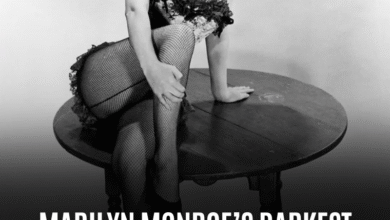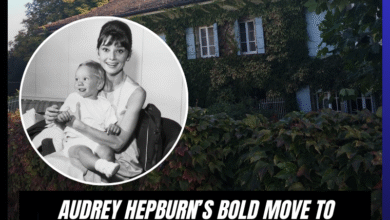The Untold Story of Audrey Hepburn’s Wartime Trauma: Starvation, Resistance, and Survival
OPINION: This article may contain commentary which reflects the author's opinion.
Audrey Hepburn is often celebrated as the epitome of grace and elegance, immortalized in films like Breakfast at Tiffany’s and Roman Holiday. However, the Hollywood portrayal of her as a fragile damsel in need of protection scarcely scratches the surface of her complex, and at times, traumatic life. From her tumultuous childhood in wartime Europe to her years as an iconic actress and humanitarian, Hepburn’s story is one of resilience, hardship, and personal transformation that is rarely told in full.
A Troubled Early Life
Born in 1929 to Baroness Ella van Heemstra, a Dutch aristocrat, and Joseph Ruston, a British man born in the town of Auschwitz, Hepburn’s early years were marked by significant challenges. When Hepburn was just six years old, her father abandoned the family, leaving them to navigate the upheaval of World War II without him. Despite the early abandonment, Audrey maintained a financially supportive but emotionally distant relationship with her father later in life. The emotional void left by her father’s absence would shape much of her personal relationships in the years to come.
Her family’s political affiliations only complicated matters further. Both her father and mother were known for their support of fascist ideologies. Hepburn’s father was a close associate of English fascist Oswald Mosley, while her mother wrote for The Blackshirt, a British fascist newspaper. These ties to Nazism were a source of shame for Hepburn later in life, though her son, Sean Hepburn Ferrer, has clarified that some of the more sensational claims—such as her mother having lunch with Adolf Hitler—are likely Hollywood fabrications.
Life During Nazi Occupation
As the Nazis swept through Europe, Hepburn’s mother, believing the Netherlands would remain neutral, moved the family back to Arnhem. It was there that Audrey continued her ballet training at the Arnhem Conservatory, although her dream of becoming a ballerina would eventually be dashed by the war. Despite this setback, Hepburn excelled as a student, becoming the star pupil of her ballet tutor, Winja Marova.
However, the reality of war soon interrupted Audrey’s artistic aspirations. When the Nazis invaded the Netherlands in 1940, the world around her descended into chaos. Audrey’s family faced unimaginable hardship, as food became scarce and her uncle, Otto van Limburg Stirum, was executed for his role in the Dutch resistance. Her half-brother was also deported to a labor camp in Berlin. Hepburn witnessed the brutality of the war firsthand, including the forced deportation of Jewish families to concentration camps, including one in Auschwitz, near her father’s birthplace.
In a deeply poignant memory, Hepburn recalled meeting the gaze of a young boy, dressed in an ill-fitting overcoat, as he was herded into a cattle car bound for a concentration camp. This moment haunted her for the rest of her life, and it became a symbol of the trauma she endured during the war. Her mother, deeply affected by the atrocities she witnessed, renounced her earlier support for fascism and began aiding the Dutch resistance. Hepburn, though still a teenager, may have also played a role, with Ferrer claiming that she would carry messages hidden in her shoes.
Surviving the War and Finding Purpose
The harsh realities of the war took a toll on Hepburn’s health. By 1945, she was gravely ill, diagnosed with jaundice, anemia, and a respiratory infection. Hepburn’s recovery was nothing short of miraculous. With the help of a former lover of her mother’s, who sent cigarettes from a British POW camp to be sold on the black market, Hepburn’s family was able to secure the penicillin needed to save her life.
This period of suffering, while tragic, also shaped Hepburn’s determination to survive and thrive. Her wartime experiences fostered in her a deep sense of empathy and resolve, traits that would define her career and later humanitarian work. Though the war had crushed her dream of becoming a ballerina, it opened the door to acting. At the age of 22, she was discovered by the French author Colette, who cast her in the lead role of Gigi, a French film adaptation of Colette’s novella.
A Star is Born
From there, Hepburn’s career moved at lightning speed. Her old-world beauty, steely determination, and resilience made her the perfect fit for the role. Though Hepburn would forever be linked to her cinematic persona as the epitome of grace, charm, and vulnerability, the truth behind her journey was far more complex. Behind her poised exterior was a woman who had overcome unimaginable hardship and trauma. Hepburn’s life as an actress, especially in her roles as the quintessential romantic lead, often overshadowed the remarkable strength and depth she possessed as a person.
The Humanitarian Legacy
Beyond her film career, Hepburn’s compassion for others remained a defining aspect of her character. After the war, she dedicated much of her life to humanitarian work, especially as a UNICEF Goodwill Ambassador. Her personal history and the suffering she had endured made her uniquely attuned to the plight of children in impoverished and war-torn regions, and she worked tirelessly to improve the lives of countless young people around the world.
Audrey Hepburn’s legacy, though often reduced to her iconic roles in films like Breakfast at Tiffany’s, is far richer and more nuanced than Hollywood allows. She was a survivor, an advocate, and a woman whose life was shaped by the traumas of war and the resilience that emerged from them. The story of Audrey Hepburn is not just one of fame and beauty—it is a story of strength, empathy, and an unwavering commitment to helping others. The true Audrey Hepburn is far more extraordinary than the fragile, idealized image Hollywood sought to sell.



